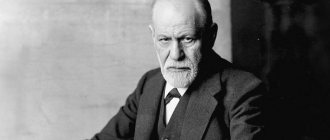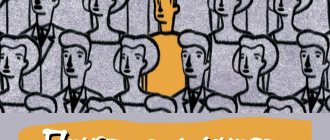In essence, healing occurs through love.
From Freud's letter to Jung, December 4, 1906
In the previous article we looked at the characteristics of “wild” psychoanalysts
who have not received any relevant psychoanalytic education at all.
Unfortunately, even the high requirements for training psychoanalysts within the IPA
, described in the article
Who is a psychoanalyst?
, cannot guarantee high professional suitability.
This is partly due to the fact that some psychoanalysts remain adherents of classical psychoanalysis
.
What is psychoanalysis
Psychoanalysis is a theory founded by Sigmund Freud, as well as a method for eliminating psychological problems.
When developing the theory, the famous Austrian psychotherapist used many years of experience gained during his medical practice.
So, what do the basic principles of psychoanalysis say?:
- Conflicts between the conscious and unconscious can lead to neuroses, fears, depression and other mental disorders.
- A person’s experience, knowledge and behavior are formed on the basis of his irrational unconscious drives.
- An individual trying to realize these drives “turns on” defense mechanisms that interfere with the process of awareness.
- The influence of the unconscious can be neutralized through its awareness. Psychoanalysis is a therapy that involves solving a problem.
The key idea of psychoanalysis comes down to the statement that a person is not aware of his own motives for behavior - they need interpretation. According to Freud's classical psychoanalysis, the patient should voice all his thoughts, associations, and dreams. The task of a psychoanalyst is to analyze what he hears.
Logotherapy
Many authors have tried to systematize all human actions and experiences. Some of the authors reduced all desires and actions to two motives: achieving maximum love and power. Others - to search for the meaning of life and self-actualization. The direction of practical psychology, which considers the search for the meaning of life and its implementation as the motive of all human actions, is called logotherapy. The founder of this direction is V. Frankl. Basic principles of logotherapy:
- a person cannot live a normal life if he does not have a goal and meaning in life;
- The meaning of life is not given to a person from the outside, it cannot be offered or imposed, a person must find it on his own.
Frankl considers the search for meaning in life to be the main driver of human behavior. Frankl divides all human actions into developmental, destructive and indifferent. A person is responsible for his actions. He is free to make decisions and choices, but the meaning of everyone’s life is realized only when we perform actions that contribute to the creation of our spirituality. According to Frankl, the question of the meaning of life, the desire to find it, is natural for any person. When a person does not see the path to this, he begins to have psychological difficulties and negative experiences. And the meaning of life, according to Frankl, exists in any moments of life, even tragic ones. The psychologist must help the client understand this meaning, especially in traumatic situations (situations of death of relatives, in military events). The meaning of life, Frankl argues, must be sought in creativity, in emotions, in humility. In order to help a person find the meaning of life, Frankl offers the following techniques: 1. The dereflection technique consists of removing excessive self-control and excessive self-digging. It is important for the psychologist to show the client that soul-searching is unproductive, it only takes up time and energy. 2. Methodology of paradoxical intention (intention - intention). It consists of leading the client to do exactly what he is trying to avoid. Using humor will help inspire the client to do this, since Frankl considers humor a form of freedom. So, if a person is afraid of closed spaces, he is asked to force himself to stay there for a long time. As a result, as a rule, fear disappears, and the person ceases to be afraid of what he previously avoided. 3. Socratic dialogue is a kind of verbal duel that reveals contradictions in the client’s judgments. The psychologist consistently, with the help of questions, leads the client to the planned conclusion. Questions are selected in such a way that the client gives as many positive answers as possible. 4. Personal understanding of life. This technique helps you find the meaning of life when it is lost by realizing your uniqueness and irreplaceability. A person who has lost the meaning of life needs to be shown that another person needs him, that the life of another without him loses meaning (for example, a woman who has lost a child can create a fund to help mothers who find themselves in a similar situation).
History of psychoanalysis
The history of psychoanalysis dates back to 1880, in the days when the Viennese physician J. Breuer shared with his comrade S. Freud a remarkable story about a patient who was cured of the symptoms of hysteria after a hypnosis session. At the reception, she was able to voice a deeply traumatic event that happened to her. The result was a strong emotional reaction. Catharsis resulted in a significant reduction in symptoms. When the patient emerged from the hypnosis state, she had no memory of her confessions.
Freud decided to apply the technique with his patients - Breuer's results were confirmed. The partners shared their findings in a joint publication, Research on Hysteria, arguing that the symptoms of hysteria are caused by repressed memories of traumatic events. The difficult situation is repressed from consciousness, but continues to influence the patient.
Personal reasons prompted Breuer to withdraw from research and Freud began independent work. He was able to discover that a similar result is achieved not only with hysteria, but also with obsessive states of a sexual nature, often arising in childhood.
The psychoanalyst initially considered the Oedipus complex to be the key cause of neuroses. The symptom begins to form at moments when the child’s unconscious drives threaten to break through the barrier set by repression, which turns out to be unacceptable for other parts of the psyche due to fear of punishment and for moral reasons.
Basics of psychoanalysis
Psychoanalysis is a therapy based on several immutable principles:
- First of all, the principle of determinism is implied. According to the ideas of psychoanalysis, not a single manifestation of the psyche can be called random, unrelated to anything, or involuntary. Conscious feelings, thoughts, impulses should be considered as events of cause-and-effect interactions determined by early childhood experience. Special research methods (mainly through dream analysis and associations) reveal the connection between situations from the past and current psychological experience.
- The basis of the second principle was the topographical approach. All mental elements are assessed according to the criteria of their accessibility. Repression, which ensures the removal of certain psychological elements from consciousness, indicates that a certain part of the psyche is making efforts without wanting to realize them.
- The third dynamic principle is based on the theory that the psyche is driven to action by impulses of aggression and sexuality, which are elements of a common biological heritage. They have significant differences from the instinctive behavior of animals. In the animal world, a stereotypical response is usually recorded, provoked by special stimuli in certain situations and aimed at survival. Psychoanalysis considers attraction as a state of nervous excitement, which is a response to stimuli that direct the psyche to action and relieve tension.
- The fourth principle is the genetic approach. The personality traits of an adult, characterizing his conflicts and neurotic symptoms, are generally associated with the fantasies and desires of childhood. It is believed that no matter what paths open to a person, he will not be able to escape from his own childhood experiences - in any case, they will haunt him throughout his life.
Methods of psychoanalysis
Let us consider in detail the main methods used in the field of psychoanalysis: the method of dream interpretation, the method of free association, the method of interpretation. Let's describe each one separately.
Free association method
What is this famous method based on? On the use of the phenomenon of associative thinking in order to study deep mental phenomena and processes (often they are unconscious). The data obtained are used for the treatment and correction of functional mental disorders, with the help of the patient’s awareness of the nature and source of the problems.
What is special about the free association method? In a conscious joint and purposeful confrontation between the therapist and the patient with a state of psychological discomfort. Acting together, the psychoanalyst and the patient cope with the problem.
The method of free association can be called a method for studying the mental state of a patient. He talks about any thoughts that come into his head, no matter how absurd or inappropriate they may seem. They may sound fantastic, ordinary, obscene. The therapist has to draw a conclusion from these revelations or incoherent fragments of thoughts.
In the “Dictionary of Psychoanalysis” (J.B. Pontalis, J. Laplanche) it is noted that free associations can be called the expression of all indiscriminately ideas and thoughts that arise in the mind - spontaneously or starting from any element (number, word, image from a dream).
Freud called for abandoning the role of controlled consciousness, beginning to understand mental processes. He stated that consciousness tries to eliminate images and thoughts that appear on the periphery before the attention of the analyzing object is focused on them. Moreover, when analyzing the mental state, it is these images and thoughts that can carry special meaning.
It was Freud who first began to actively use the method of free association. The psychoanalyst suggested that his patients lie down on the couch and relax, simply saying whatever came to their mind, no matter how incredible, absurd and unusual these thoughts were from the point of view of usual moral standards. During the sessions, the therapist observed how powerful emotional drives led uncontrolled thinking to mental conflict. The famous psychotherapist stated that the first random image and thought implies exactly what is needed for psychoanalysis. A random thought may have a connection to a repressed memory.
Dream interpretation method
According to the theories of Sigmund Freud, dreams can reveal the presence of intense mental activity in the depths of consciousness. What is dream analysis? The therapist must find the distorted unconscious truth hidden in every dream. Freud was convinced: the stranger and more confusing the dream, the more hidden content it contains. In the language of psychoanalysis, this phenomenon is called resistance - its manifestations can be noticed even when the person who saw the dream does not agree to its interpretation. This speaks of his unconscious resistance, established barriers to protect his own psyche.
Dreams separate the unconscious from the real world. In them, exciting situations that cause emotions are deformed in the most bizarre way. Dreams can also tell about secret desires. In the case of child psychoanalysis, the differences between hidden and overt thoughts are less clear.
Hidden thoughts are transformed into symbols, appearing in a form acceptable to consciousness. This allows them to bypass certain "censorship". Even today, the manifestation of the unconscious in the form of dreams remains one of the greatest mysteries of consciousness.
The method of dream interpretation is very important - it allows you to identify the essence of the images that appear in a dream. Freud processed dreams by positioning them as symptoms of illness. According to him, for the correct use of this method, it is not recommended to consider dreams as something single - such an analysis will not lead to anything worthwhile. He was convinced: when analyzing dreams, it is necessary to painstakingly study its elements separately. The association rule should be applied to individual fragments. Freud considered any dream not only an object worthy of scientific research, but also a way to know one’s deep essence, to discover hidden desires that do not appear on the surface.
Interpretation method
Interpretation is considered one of the most important tools of any analyst. Even in the interpretation of dreams and free associations, interpretations are used by the therapist. What does this term mean?
Interpretation is called the main analytical tool. In dream interpretation and free association, the psychoanalyst attempts to use interpretations. We are talking about transferring significant information about the patient from the unconscious level to the conscious level. Repressing information that causes concern and anxiety in an individual, as well as its correct analysis, will soften the symptoms of neurosis or other mental problems.
Transactional analysis
E. Berne created a popular concept rooted in psychoanalysis. While studying human communication, he described three I-states that exist in every person. Depending on the communication situation, one of these three components, and sometimes they together, comes to the fore. All these three components of personality are necessary. A parent is rules of behavior, prohibitions, norms, the need to advise, to take care of. A person learns this information from his parents or other people who are authoritative for him. When the Parent is blocked in the personality structure, the person becomes immoral and unprincipled. A child is an ego state when gullibility, spontaneity, creativity are manifested, as well as capriciousness, touchiness, stubbornness, and frivolity. An adult is a state when rationalism, objectivity, and decision-making based on one’s own experience prevail. Correction, according to Berne, should be aimed at consolidating permanent adult behavior. Mottos: I want a child, I like it. Adult – expedient, useful. Parents must.
E. Bern describes certain stereotypes in the way people communicate with each other. 1. The first behavioral stereotype is play. This is an unconscious program of human behavior, the purpose of which is to avoid close communication with another person or to receive positive emotions. Each participant plays a specific role. The stages of the game contain strike, response, trap, payback, reward. Every action is accompanied by certain feelings. The game is played between the states of one person (Parent, Adult, Child) or between two individuals, sometimes between an individual and a group. The outcome of the game is always predictable. Winning is the emotional state that the player strives for. 2. The second stereotype in interpersonal communication is stroking and hitting. Any interaction between people contains strokes and blows, with their help people convey positive or negative emotions to each other. Strokes can be positive (“You look wonderful today”) or false (“This scarf suits you very well, it covers the wrinkles on your neck”). Positive strokes are necessary for every person. If there is a lack of physical strokes, a person needs a large number of psychological strokes. Psychological blows and strokes are interconnected: the more positive strokes a person receives, the less psychological blows he produces. 3. There is such a way of behavior as extortion. This is a way of communication in which a person causes negative emotions in himself, demanding others to calm him down. For example, a person constantly complains. He does this in order to receive emotional and psychological support from his communication partner. 4. Transactions. The unit of communication is a transaction consisting of a stimulus and a response. A addresses B, sending a communicative stimulus, B responds to him. The purpose of transactional analysis is to find out which self-state A sent a stimulus to B and which self-state B responded. When the Adult of one person sends a signal to the Adult of another person, Parent to Parent, Child to Child - this is a type of parallel transactions. With such a transaction, non-conflict relationships develop that can last quite a long time. The conflict begins to develop during cross transactions. These transactions are carried out between unequal components of the personality structure (Parent - Child, Parent - Adult, Child - Adult, Child - Parent). The result of this transaction will be reproaches and conflicts. Covert transactions involve more than two ego states. The stimulus in such a transaction is disguised as socially acceptable, and a real reaction to it is expected. For example, a young man invites a girl he likes to drink coffee. She thanks him and agrees. At a conscious level, the conversation goes along the line Adult - Adult, and at the psychological level along the line Child - Child (“I like you” - “I like you too”).
5. Psychological position and personal attitudes. Every person has basic ideas about himself, about others and about the world around him. It is these basic attitudes that influence his behavior and decision-making. If a person is lucky, accepted by other people, confident in himself, there is no doubt that his life position is: “I am prosperous - you are prosperous.” A person with such a position believes that his life and that of every person is of great value. Therefore, he maintains good relationships with others, avoids conflicts, and does not waste time and energy fighting with himself and others. Anyone who believes that his life and the lives of other people are worthless, who abuses alcohol, smoking, drugs, leads an antisocial lifestyle, has the attitude in life: “I am unfavorable - you are unfavorable.” This is a position of despair and disappointment. It is formed in a person who is spoiled by attention and care, and then for some reason is deprived of such attitude. A person who values himself and his life very low, and others highly, stands in the position “I am unfavorable - you are prosperous.” This person is unsure of himself, does not take any initiative, values his work low, and takes the blame for everything that happens. “I am prosperous - you are not prosperous” - this attitude of arrogant superiority. A person with such an attitude values his life and his “I” very highly, but does not value the other person. This attitude is formed either in children raised in an atmosphere of reverence and forgiveness, or in children who live in conditions that threaten life and their dignity. All these attitudes, parental programs, social roles that people play, series of transactions predetermine the life of each person. By analyzing them, you can predict the next stage of a person’s life, and sometimes how the play of life will end. Therefore, E. Berne speaks of a life scenario that a person steadily follows or fiercely resists. So, transactional analysis includes analysis of personality structure, analysis of transactions, analysis of psychological games, analysis of individual life scenario. Transactional analysis is carried out in order to help the client understand his games, his life scenario. If the client’s behavior and life are unproductive, help him free himself from imposed behavioral programs and psychological games, become independent, spontaneous, responsible for his actions and feelings. In transactional analysis, a psychologist for a client is a partner, teacher and expert. And communication between the psychologist and the client goes along the line Adult - Adult.
Psychoanalysis in psychology and philosophy
One can hear many general statements about psychoanalysis. It is usually noted that psychoanalysis is a well-known direction in psychology, the benefits and significance of which are assessed differently. The method has both supporters and opponents.
If we talk about psychoanalysis in a philosophical vein, it is noted that a feature of psychoanalytic concepts is their connection with psychotherapeutic practice. It is not reduced to either experimental knowledge or philosophical speculation, but grows from the experience of communication and other aspects. Real comprehension of your inner world is achieved through insight. Such insight brings changes to the patient’s life - he begins to think about himself and his beliefs in a completely different way.
This philosophy is somewhat similar to ancient teachings that combined the theory and practice of Zen Buddhism, yoga and other types of mental self-regulation.
The practice of psychoanalysis is periodically compared with the healing actions of priests and shamans. Training in psychoanalysis is equated to initiation. It is no coincidence that many famous analysts who practice psychoanalysis simultaneously show interest in various Eastern teachings and even magic.
Most adherents of Freud's theories, as before, adhere to the model of the human psyche that was supported by the “father of psychoanalysis.” Their beliefs are based on the fact that psychoanalysts usually receive psychological or medical training. Their task is to adapt the patient to surrounding circumstances. To a large extent, psychoanalysis is widespread in America and the most developed European countries.
At one time, Sigmund Freud still hoped that his theories of psychoanalysis would be recognized by the scientific community. For this purpose, he resorted to analogies with archeology, hydraulics, economics and other sciences. Gradually, the conviction began to grow stronger in him that this would not happen after all.
The first reason can be called the difference in approaches, and the second is that for scientists, whose formation took place in the scientific fields of the nineteenth century, psychoanalysis is an unacceptable aspect for personal reasons. The ideas of therapy ran counter to narcissistic illusions about the power of the mind over nature and oneself. In general, the frequency with which many representatives of science and philosophy condemned the principles of psychoanalysis indicates their obvious bias. Gradually these beliefs began to change.
Today, the scientific status of psychoanalysis periodically continues to be challenged. Some researchers are inclined to think that it is still scientific, others question this statement, calling the well-known therapy pseudoscience.
However, in the twentieth century, psychoanalysis became widespread in the humanities, psychology, philosophy and other fields.
About treatment
Psychoanalysis is said to be a long-term treatment, usually lasting from two to five years. Let's start with the very concept of healing. To heal means to restore health, but healing also means leaving pain, getting rid of it. Diderot noted that if fever is cured with quinine, then literary fame is cured by lack of recognition, unfair preferences, enmity, envy, satires... Are we not trying, if psychoanalysis is banned, to escape its very essence? Psychoanalysis is in most cases opposed to medical therapy. What is its essence? Modern medical therapy subverts long-held ideas about healing by reducing healing to metron
, measurement and evaluation. This is an insight clinic focused on quantitative methods. At the center of therapy we always find the drug, which also modulates the effect; but the center of healing is always the patient and his quality of life, his health. For Hans-Georg Gadamer, for example, health is a matter of harmony, that is, balance and the right measure, elusive and incomprehensible.
The doctor is interested in the patient, as Lacan noted in 1966 in Psychoanalysis and Medicine, in order to make him sick. But he is also interested in him so that the patient confirms his disease, in order to identify the patient with his symptom. This has several advantages for the patient. The first is getting a new place in speech, supporting an unsuccessful speech, an erroneous statement. “Failure,” that is, illness, according to Gadamer, causes the subject to lose his place in the general discourse. But the return does not come without criticism of the healing.
Michel Foucault emphasizes that modern medicine strives not for individualized action, but for mass treatment
: The population is treated with the help of “healing machines”, hospitals and medical centers. The COVID-19 epidemic has shown the failure of states in mass medical interventions, and now, increasingly, at the heart of this machinery we find the patients themselves in the role of experts. In this case, the very reason behind the disease and the request for treatment is erased.
Freud's theory of psychoanalysis: briefly
According to Freud's theory, the human psyche can be “divided” into the following components: Ego, Id and Superego.
Definition of terms:
- The id is the main source of drive and desire. As an analogy, we can cite an ordinary street dog, where all its actions, such as mating, sleeping, etc., are the result of instincts inherent in nature.
- The ego is a mediator that divides social frameworks and animal instincts. The part of the personality that satisfies the needs of the id, taking into account the limitations of the external world.
- The superego implies all social frameworks, starting with the period of parental education, when the foundations are laid for what can be done and what is unacceptable. In adult life, it is reflected in all aspects of life, such as morality, religion, law.
The topical model of the mental apparatus includes two elements: the unconscious and the conscious.
What do they mean:
- The unconscious is psychic forces that are below the level of consciousness. They determine how a person behaves.
- Conscious is a mental aspect that an individual is able to become aware of. Consciousness has a direct impact on how an individual positions himself in society. The psyche can automatically be corrected by the pleasure principle. If the balance is disturbed, then a reset occurs through the unconscious sphere.
Defense mechanisms realize the conflict between the Superego and the Id. Freud described many of them: isolation, projection, repression, denial, substitution, regression and so on.
Classic psychoanalysis by Sigmund Freud
Having begun to develop a new approach to the treatment of mental problems, Freud initiated his own research and studied the data of other scientists. Nowadays the theory of psychoanalysis is considered truly unique. What distinguishes her from others is that she does not undertake to study individual problems of an individual. Psychoanalysis looks at everything in its entirety. We suggest that you briefly familiarize yourself with the main provisions of therapy.
Classical psychoanalysis is based on the determinism of the biological component - on the assertion that physiological needs suppress all others and indicate their vector. Mental determinism indicates that any incident in a person’s life has its consequences. Each of his actions is determined by an obvious or hidden motive, which was preceded by certain events.
Several aspects of an individual’s mental life are distinguished: conscious, preconscious, unconscious. In the first case, we are talking about experiences and current thoughts, in the second – about secret desires and fantasies, in the third – about what stands out from consciousness, suppressed by the internal censor. Freud believed that psychology should be interested in this complex mechanism in detail.
Criticism
Psychoanalyst and philosopher John Mills has made a number of significant criticisms of the relationship movement. Mills apparently believes that this "paradigm shift" to relational psychoanalysis is not only due to theoretical differences with classical psychoanalysis, but also due to a certain group mentality and set of interests: "Relational psychoanalysis is an American phenomenon with politically influential and beneficial group of people. members advocating conceptual and technical reform "from the perspective of a group of professional psychologists:" the most prominent relationship analysts are psychologists, as are the founding professionals associated with initiating the relationship movement."
From a theoretical perspective, Mills seems to doubt that relational psychoanalysis is as radically new as it is claimed to be.
By emphasizing the importance of other people's development, according to Mills, "relational theory simply states the obvious"—taking up "a point that Freud made clear throughout his theoretical corpus, which becomes even more significant in early object relations. from therapists to modern mental health psychologists"
Mills also criticizes the diminishing or even loss of importance of the unconscious in relationship psychoanalysis, a point he raises in various parts of his book Riddles.
Psychoanalyst and historian Henry Zvi Lotane has also criticized some of the central ideas of relationship psychoanalysis from both historical and psychoanalytic perspectives. Historically, Lauthain believes that relational theorists exaggerate Freud's non-relational aspects while ignoring his relational aspects. Lotan argues that while Freud's theory of disorder is "monadic", i.e., focused more or less exclusively on the individual, Freud's psychoanalytic method and theory of clinical practice are invariably dyadic or relational. From a theoretical perspective, Lauthain criticized the term "relational" in favor of Harry Stack Sullivan's term "interpersonal". Lotan developed his concepts of "mutual free association" as well as "dramatology" as ways of understanding the interpersonal or relational dimension of psychoanalysis.
Psychoanalyst and philosopher Aner Govrin examines the high price paid to psychoanalysis for adopting postmodernism as its preferred epistemology. He argues that only analysts who thought they "knew the truth" created classical, interpersonal self psychology, ego psychology, Kleinian, Bionian, Fairbairnian, Winkcottian and other schools of thought. While the relationship tradition has made outstanding and positive contributions to psychoanalysis, and its postmodern epistemology is indeed moderate, the American relationship tradition as a political movement has had an undesirable psychological and sociological impact on psychoanalysis. This has led to a serious decline in the positive image of knowledge, which is crucial for the construction of new theories. Led by the relationship movement but influenced by the much broader movement of Western philosophy and culture, this influence greatly influenced international psychoanalysis. This led not only to the neglect of the school era, but also to the devaluation of any attempt to find out the truth.
Taking a more sympathetic line of criticism, Robin S. Brown suggests that while relational thinking has done much to challenge psychoanalytic dogmatism, overemphasizing the formative role of social relations can lead to its own form of authoritarianism. Brown argues that the shift in attitudes does not sufficiently take into account the role of first principles and that this trend can be challenged by analytical psychology.
Psychoanalysis of modern times
Sigmund Freud was convinced that all our actions are dictated by subconscious desires. Particular emphasis was placed on the fact that emerging needs are based on physiology and sexual desires. Modern psychology no longer focuses on this and does not pay too much attention to the statement.
How widespread is psychoanalysis today? In many countries it is quite developed, being quite an ordinary phenomenon. Many modern therapists write books on this topic, which are very popular - that is, it is in demand. Of course, a certain type of society has long resisted the principles of psychoanalysis, not accepting them. This can be said about Germany during the period of National Socialism and the USSR before the Brezhnev stagnation. These examples are the most obvious. Both the fascist and communist regimes opposed Freud's teachings on ideological grounds. The Germans considered these theories “Jewish science that degrades human dignity,” and the Soviet Union considered these theories “the apotheosis of bourgeois individualism.”
Both hidden attempts to oust the teaching from the life of society and obvious repressions against it are known. It is worth recognizing that psychoanalysis also runs counter to many religion-centered and theocratic societies. Although there are cases when it was successfully developed in countries with authoritarian political regimes. The most obvious example is Argentina. According to the assumption of the Argentine psychotherapist A. Benjamin, the reason is that it was the psychologist’s office that usually became the last refuge for oppressed citizens, where freedom of speech was not prohibited.
To summarize, the conclusion suggests itself that freedom is considered the main condition for the successful development of psychoanalysis in society. Let us clarify that in this case, society should share the value of freedom, it should demonstrate the real implementation of freedoms (personality, speech, thought). By the way, for the full development of psychoanalysis, freedom of association is required, which makes it possible for the corresponding community to take shape.
In general, psychoanalysis is quite common in modern society. Various trainings are conducted, therapeutic rooms operate, and relevant literature is published.









